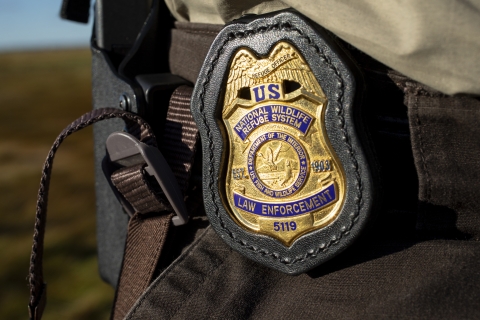Management and Conservation
The diversity of habitats contributes to the diversity of species occurring on Minidoka National Widllife Refuge. The open water areas contain large shallow beds of submergent vegetation. These areas support the large number of molting geese and ducks that can exceed 100,000 birds during late summer and early fall. These aquatic plant beds also support large numbers of warm water and trash fish, which in turn provide food for colonial nesting bird species, and high populations of river otters and mink.
Managing Habitat for Protected Species and Species of Concern
The reservoir is habitat for the Utah valvata, an endangered snail. The upland habitats support a variety of shrub-steppe and grassland bird and mammal species. The basalt lava flows provide habitat for some of the more diverse reptile faunas in Idaho. The Idaho dunes tiger beetle, a species of special concern, is found on refuge sand dunes. Several wildlife surveys are performed every year.
Wetland Areas
Management of wetland areas focuses on providing undisturbed habitat for wildlife. Undisturbed areas are essential for colonial nesting birds, especially American white pelicans, and for molting waterfowl. Undisturbed habitat of this quality and quantity do not occur anywhere else in southeast Idaho. The shallower areas and areas near colonial bird nesting islands are closed to boat traffic.
Reservoir Levels
Water levels in the main reservoir are controlled by the Bureau of Reclamation. Levels are raised early in the spring and held stable till late fall so there is no danger of nest flooding.
Wildlfire Control, Management, and Prevention
Wildfire control and prevention are important practices; wildfires reduce sagebrush sagebrush
The western United States’ sagebrush country encompasses over 175 million acres of public and private lands. The sagebrush landscape provides many benefits to our rural economies and communities, and it serves as crucial habitat for a diversity of wildlife, including the iconic greater sage-grouse and over 350 other species.
Learn more about sagebrush and juniper and favor exotic native grasses, such as cheat grass. Cheatgrass can out-compete native plant species and increase fire frequencies, further degrading the habitat. When and where possible, native grasses, forbs, and shrubs are reseeded after wildfires. Integrated pest management is practiced to reduce noxious weeds and promote desirable species .
Prescribed fires are another management tool used at Minidoka. Prescribed fires are intentionally set under controlled conditions to achieve specific management objectives. The use of prescribed fire is widely accepted as a primary tool for habitat restoration and management.
Law Enforcement
If you have any questions about Law Enforcement on the Refuge or concerns about activities, please call the Southeast Idaho National Wildlife Refuge complex at 208-237-6615, or contact the refuge manager at Minidoka at 208-436-3589.
